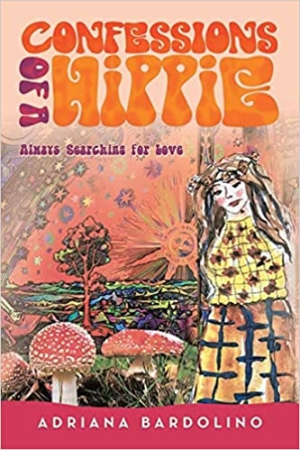Confessions of a Hippie
Always Searching for Love
In the memoir Confessions of a Hippie, hippie culture is seen through the eyes of a woman who was part of it.
Adriana Bardolino’s memoir Confessions of a Hippie covers life on various communes.
The book chronicles an eight-year period, from 1967 to 1975. Bardolino was first introduced to communal living at the age of twenty-one, when she and her boyfriend Noah moved from New York to California. From then until she moved to Hawaii, her life was characterized by a constant back-and-forth between communal houses and New York, with the occasional stay at a friend’s apartment. During this period, she worked on a temporary basis, when she was not living with a boyfriend, or when her savings were running out. She also took college courses and took on different artistic ventures.
Bardolino conveys her emotions with great clarity, and deep joy infuses the book’s early chapters about her first explorations of the country and of communal living. Her artistic bent was more prominent, as she was happy and excited about the future, in those beginning days. The sections dealing with her first move to California are happy and eager, while those centered on her own summer of love in 1970 are permeated with enthusiasm.
Much of the memoir is focused of Bardolino’s romantic relationships, though, and accounts of them are monotonous, following a repeating and destructive pattern. With few exceptions, the men in her life come across as interchangeable. More compelling is Bardolino’s general dissatisfaction and search for fulfillment, which becomes more prominent farther into the book, when party environments no longer hold her interest, and she becomes disillusioned with the sameness of her romantic relationships. But the book’s tendency to attribute unpleasant moments, or to blame Bardolino’s actions, on her circumstances, or on other people, is off-putting, as is the excuse that she “just couldn’t help herself,” which arises, in particular, when her actions caused somebody else pain. The disbandment of her group of friends pushed her to make changes in her life.
The book’s chapters are introduced by quotes from books and songs, which are used to set the mood for the stories to come. Bardolino’s paintings and photographs are also used to fill in the book’s background, capturing places that were important to her and period fashions. These make the memoir’s peek into the memorable twentieth-century phenomenon of communes more intriguing. Bardolino captures hippie culture with clarity, conveying its push for freedom and its political persuasions well. The book becomes an ongoing search for meaning.
In the memoir Confessions of a Hippie, hippie culture is seen through the eyes of a woman who was part of it.
Reviewed by
Carolina Ciucci
Disclosure: This article is not an endorsement, but a review. The publisher of this book provided free copies of the book and paid a small fee to have their book reviewed by a professional reviewer. Foreword Reviews and Clarion Reviews make no guarantee that the publisher will receive a positive review. Foreword Magazine, Inc. is disclosing this in accordance with the Federal Trade Commission’s 16 CFR, Part 255.

